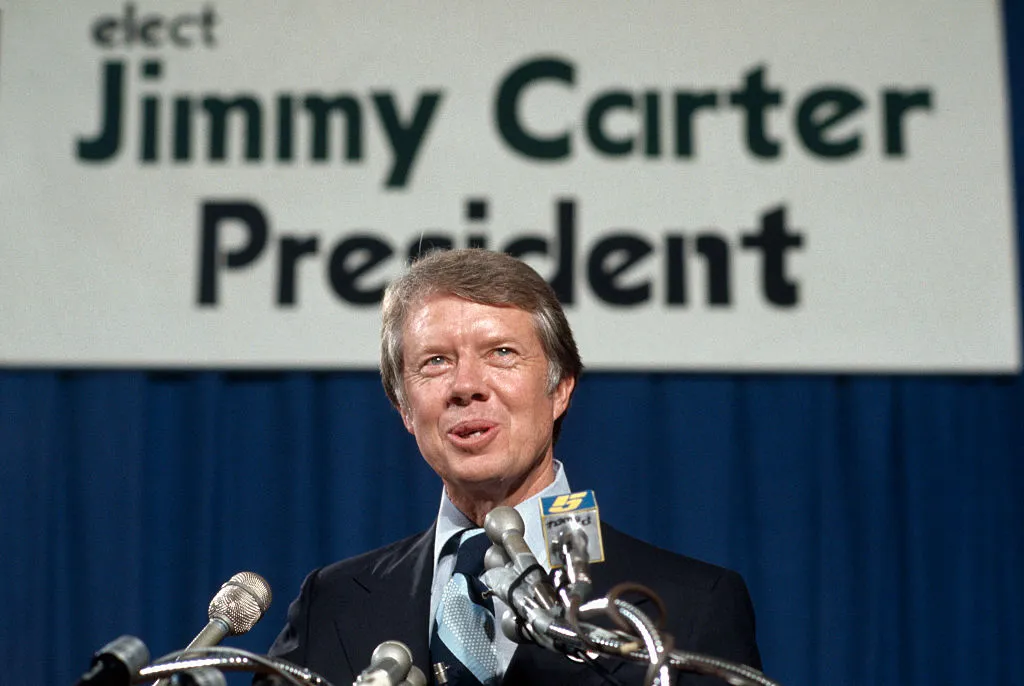
On Sunday, the Carter Center in Atlanta announced that Jimmy Carter, the 39th president of the United States, has died at 100 years old. While Carter was best known as a tireless advocate for human rights and world peace, he also leaves behind a long legacy of support for the arts and freedom of expression.
Carter’s connection to the world of art began during his successful presidential campaign in 1976. That year, in a bid to position the then-governor of Georgia as a fresh-faced progressive, the Democratic National Convention commissioned Andy Warhol to create a portrait of Carter at his home (and peanut farm) in the quiet city of Plains. Warhol made three portraits, but it was the photo-collage Jimmy Carter I that was sold in prints to raise money for the campaign.
After Carter entered the presidency in 1977, he invited five American artists, including Warhol, to the White House for the opening of the exhibition “Inaugural Impressions,” which included commissioned works showing Carter’s inauguration. The other artists were Jacob Lawrence, Jamie Wyeth, Roy Lichtenstein, and Robert Rauschenberg. The works were also sold as a limited-edition portfolio that raised money for the Inaugural Committee and paid to keep museums open in D.C. during inauguration week.
In 1978, Carter signed a bill doubling the budget of the National Endowment of the Arts (NEA). He also opened the East Building of the National Gallery of Art, which was designed by famed modernist architect I. M. Pei. At the time, Carter called the addition an “architectural masterpiece.”
It was in that speech that Carter most clearly laid out his view of the relationship between arts and the public sector in the US. He noted that while the NGA is “maintained at public expense,” the museum “owes its existence to acts of private philanthropy” and that its acquisitions are funded “entirely from private donations.” He further noted that his increased support for the NEA came primarily in the form of “challenge grants,” or government funds matched by private donations.
“In an open society like our own, the relationship between government and the arts must necessarily be a delicate one,” he said. “We have no ministry of culture in this country, and I hope we never will. We have no official art in this country, and I pray that we never will. No matter how democratic a government may be, no matter how responsive to the wishes of its people, it can never be government’s role to define exactly what is good or true or beautiful.”
The vision of public and private funding working in concert is still today the model that dominates arts institutions throughout the US.
Also in 1978, Carter signed the Comprehensive Employment and Training Act Amendments, which revised and extended a Nixon-era program that federally employed over 10,000 artists during the period it was active. At its peak, in 1980, it funneled $300 million into the cultural sector of the US typically by providing grants to local arts nonprofits.
And in 1980, during his last year in office, Carter signed a bill authorizing the siting of the Vietnam Veterans Memorial, which was eventually designed by architect Maya Lin, who won a design contest as an undergraduate at Yale. In that work, two black granite walls are engraved with the names of Americans who died in the Vietnam War, which in his campaign Carter promised to move the country past.
In his later years, Carter took up oil painting and furniture-making. Last year, the Carter Center, the organization he and his wife Rosalynn founded after he left the presidency, sold a 2013 painting of his, of a bald eagle, for $225,000 as part of its annual fundraiser.

